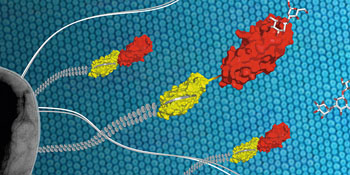Structural Studies Reveal Molecular Basis for Bacterial Motility in the Urinary Tract
By LabMedica International staff writers
Posted on 23 Mar 2016
A team of molecular microbiologists has unraveled the mechanism used by Escherichia coli bacteria to bind to cells lining the urinary tract and explained how the pathogen migrates to the bladder despite the strong force of urine flowing in the other direction. Posted on 23 Mar 2016
E. coli attaches to host epithelia via the fimbrial adhesion FimH, a two-domain protein at the tip of type I pili recognizing terminal mannoses on epithelial glycoproteins.

Image: Using the protein FimH (yellow/red) located at the tip of long protrusions, the bacterial pathogen E. coli (grey) attaches to cell surfaces of the urinary tract (Photo courtesy of Maximilian Sauer, ETH Zürich).
Investigators at the University of Basel (Switzerland) and ETH Zurich (Switzerland) established a model system for fimbrial FimH function. A fimbril is a proteinaceous appendage in many gram-negative bacteria that is thinner and shorter than a flagellum.
The investigators revealed, in a paper published in the March 7, 2016, online edition of the journal Nature Communications, a three-state mechanism of FimH catch-bond formation based on crystal structures of all states, kinetic analysis of ligand interaction, and molecular dynamics simulations. They found that FimH bound to sugar structures on the cell surface increasingly tightly the more it was pulled. As strong tensile forces developed during urination, FimH protected the bacteria from being flushed out. In the absence of tensile force, the FimH pilin domain allosterically accelerated spontaneous ligand dissociation from the FimH lectin domain by 100,000-fold, resulting in weak affinity and allowing the bacteria to release from the cell surface and migrate in the direction of the bladder.
“Through the combination of several biophysical and biochemical methods, we have been able to elucidate the binding behavior of FimH in more detail than ever before”, said senior author Dr. Rudolf Glockshuber, professor of molecular biology and biophysics at ETH Zurich. “The protein FimH is composed of two parts, of which the second non-sugar binding part regulates how tightly the first part binds to the sugar molecule. When the force of the urine stream pulls apart the two protein domains, the sugar binding site snaps shut. However, when the tensile force subsides, the binding pocket reopens. Now the bacteria can detach and swim upstream the urethra.”
Related Links:
University of Basel
ETH Zurich













